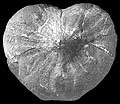The Echinoid Directory
Paronaster Airaghi, 1906, p. 107
| Diagnostic Features |
|
|---|---|
| Distribution | Late Cretaceous (Scaglia - i.e. Coniacian-Campanian), Italy. |
| Name gender | masculine |
| Type | Paronaster cupuliformis Airaghi 1906, p. 108, by original designation. |
| Species Included | Only the type species. |
| Classification and/or Status | Spatangoida or Holasteroida; family unknown. Monotypic. |
| Remarks | Lack of knowledge of plastron plating makes it impossible to place this genus with any certainty. It differs from all other holasteroids in its strongly conical aboral surface and by the subpetaloid nature of the frontal ambulacrum. Possibly a spatangoid, since the apical disc structure is unknown. C. Airaghi 1906. Un nuovo genere della sottofamiglia delle Echinocorynae. Atti della Societa Italiana di Scienze naturali e del Museo Civico di Storia Naturale in Milano 45, 107-110. |

